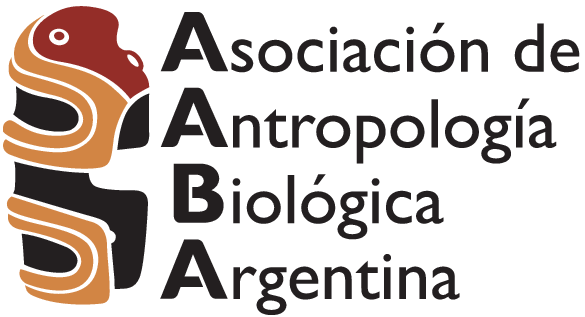Error intraobservador en el análisis paleohistológico de superficies craneofaciales / Intra-observer error in paleohistological analysis of craniofacial surfaces
Resumen
En el análisis histológico de las superficies óseas craneofaciales se registran rasgos microestructurales producidos por la actividad de modelado óseo, así como otros rasgos no vinculados al crecimiento normal (alteraciones tafonómicas). La identificación de las áreas producto de la actividad celular, así como la determinación de su distribución y su extensión total, puede estar sujeta a diversas fuentes de error. En este sentido, el objetivo del presente trabajo es evaluar el error intraobservador en el relevamiento de las microestructuras correspondientes a formación y reabsorción sobre superficies óseas craneofaciales vinculadas al modelado óseo. Para ello se realizó un diseño observacional de bloques completos aleatorios con medidas repetidas a partir de réplicas de alta resolución de la glabela, el malar y el maxilar observadas al microscopio de luz incidente. Los resultados permitieron detectar la existencia de tendencias en las observaciones a través del tiempo, así como diferencias en el reconocimiento según el tipo de superficie ósea y la región analizada. En general, se registró un aumento de la concordancia a través de las repeticiones en la observación del tipo de actividad y en la cuantificación de la extensión de las áreas de formación y reabsorción. Asimismo, se observó que presentan mayor dificultad en su análisis los rasgos asociados a la actividad de reabsorción así como las regiones con topografía abrupta, como la región maxilar. Estos resultados proveen un marco de referencia para evaluar la confiabilidad de las observaciones en futuros estudios paleohistológicos.
PALABRAS CLAVE error de observación; diseño experimental; superficies de modelado óseo
Histological analysis of craniofacial bone surfaces reveals microstructural features produced by the activity of bone modeling, as well as other features not related to normal growth (taphonomic alterations). Identifying the areas produced by cell activity and determining their total size and distribution may be subject to various sources of error. In this sense, the objective of this study is to evaluate intra-observer error in the analysis of microstructures corresponding to formation and resorption on craniofacial bone surfaces linked to bone modeling. To this end an experimental random complete block design with repeated measurements was performed using high-resolution replicas of the glabella, malar and maxilla observed at incident light microscope. The type and extension of each cell activity-formation and resorption-were registered. The results revealed the existence of trends in observations over time, as well as differences in the recognition by type of bone surface and region analyzed. In general, an increased consistency across repetitions in the observation of the type of activity and in the quantification of formation and resorption areas was recorded. It could also be observed that the traits associated to the activity of resorption and the regions with a steep topography, such as the maxillary region, are more difficult to analyze. These results provide a framework for assessing the reliability of paleohistological observations in future studies.
KEY WORDS measurement error; experimental design; bone modeling surface
Descargas
Métricas
Citas
Arnqvist G, Mårtensson T. 1998. Measurement error in geometric morphometrics: empirical strategies to assess and reduce its impact on measures of shape. Acta Zool Acad Sci Hung 44 (1-2):73-96.
Azzimonti Renzo JC. 2005. La concordancia entre dos tests clínicos para casos binarios: problemas y solución. Acta Bioquím Clín Latinoam 39(4):435-444.
Barbeito Andrés J, Pucciarelli HM, Sardi ML. 2011. An ontogenetic approach to facial variation in three native American populations. Homo 62:56-67. doi:10.1016/j.jchb.2010.10.003
Benavente A, Ato M, López JJ. 2006. Procedimientos para detectar y medir el sesgo entre observadores. Anales de Psicología 22:161-167.
Bernal V, Gonzalez PN, Perez SI, Del Papa MC. 2004. Evaluación del error intraobservador en bioarqueología. Intersecciones Antropol 5:129-140.
Boyde A. 1972. Scanning electron microscope studies of bone. En: Bourne GH, editor. The biochemistry and physiology of bone. New York: Academic Press. p.259-310.
Brachetta Aporta N, Martinez-Maza C, Gonzalez P, Bernal V. 2014. Bone modeling patterns and morphometric creaniofacial variation in individuals from two prehistoric human populations from Argentina. Anat Rec 297:1829-1838. doi:10.1002/ar.22999
Bromage TG. 1984. Surface remodelling studies on fossil bone. J Dent Res 63:491.
Bromage TG. 1989. Ontogeny of the early human face. J Hum Evol 18:751-773.
Buikstra J, Ubelaker D. 1994. Standars for data collection from human skeletal remains. Arkansas Archaeological Survey Research Series. Fayetteville: Arkansas Archaeological Survey.
Cohen J. 1960. A coefficient of agreement for nominal scales. Educational Psychology Measurement 20:37-46.
Enlow DH. 1963. Principles of bone remodelling. Springfield: Thomas CC Publisher.
Enlow DH. 1966. A comparative study of facial growth in Homo and Macaca. Am J Phys Anthropol 24:293-308.
Enlow DH, Hans MG. 1996. Essentials of facial growth. Philadelphia: WB Saunders Company.
Feinstein AR, Cicchetti DV. 1990. High agreement but low kappa: I. The problem of two paradoxes. J Clin Epidemiol 43:543-549. doi:10.1016/0895-4356(90)90158-L
Fleiss JL. 1981. Statistical methods for rates and proportions. New York: Wiley.
Guichón R, Neder S, Orellana L. 1993. Algunas consideraciones sobre los diseños de experimentos y estudios observacionales en antropología biológica. Rev Palimpsesto 3:53-61.
González PN, Bernal V, Perez SI, Del Papa M, Gordon F, Ghidini G. 2004. El error de observación y su influencia en los análisis morfológicos de restos óseos humanos. Datos de variación discreta. Rev Arg Antrop Biol 6:35-46.
Gonzalez PN, Perez SI, Bernal V. 2010. Ontogeny of craniofacial robusticity in modern humans: a study of South American populations. Am J Phys Anthropol 142:367-379. doi:10.1002/ajpa.21231
Gonzalez PN, Bernal V, Perez SI. 2011. Analysis of sexual dimorphism of craniofacial traits using geometric morN. phometric techniques. International J Osteoarch 21:82-91. doi:10.1002/oa.1109
Hillier ML, Bell LS. 2007. Differentiating human bone from animal bone: a review of histological methods. J Forensic Sci 52:249-263. doi:10.1111/j.1556-4029.2006.00368.x
Jindrová A, Tuma, Sládek V. 2012. Intra-observer error of mouse long bone cross section digitization. Folia Zoologica 61 (3-4):340-349.
Krause WJ. 2001. The art of examining and interpreting histologic preparations. New York: Parthenon Publishing.
Lander SL, Brits D, Hosie M. 2014. The effects of freezing, boiling and degreasing on the microstructure of bone. Homo 65:131-142. doi:10.1016/j.jchb.2013.09.006
Lantz CA, Nebenzahl E. 1996. Behavior and interpretation of the K statistic: resolution of the two paradoxes. J Clin Epidemiol 49(4):431-434. doi:10.1016/0895-4356(95)00571-4
Lieberman DE. 2011. The evolution of the human head. Cambridge: Harvard University Press.
Martínez-Maza C, Rosas A, García-Vargas S. 2006. Bone paleohistology and human evolution. J Anthropol Sci 84:33-52.
Martínez Maza C. 2007. Ontogenia y filogenia del modelado óseo en el esqueleto facial y la mandíbula de los hominoideos. Estudio de la línea filogenética Neandertal a partir de las muestras de Atapuerca-SH y El Sidrón. Tesis de Doctorado. Facultad de Ciencias Biológicas. Universidad Complutense de Madrid. Disponible en: http://dialnet.unirioja.es/servlet/tesis?codigo=17577
Martinez-Maza C, Rosas A, Nieto-Diaz M. 2010. Identification of bone formation and resorption surfaces by reflected light microscopy. Am J Phys Anthropol 143:313-320. doi:10.1002/ajpa.21352
Martinez-Maza C, Rosas A, Garcia-Vargas S, Estalrrich A, de la Rasilla M. 2011. Bone remodelling in Neanderthal mandibles from the El Sidrón site (Asturias, Spain). Biol Lett 7:593-596. doi:10.1098/rsbl.2010.1188
Martinez-Maza C, Rosas A, Nieto-Diaz M. 2013. Postnatal changes in the growth dynamics of the human face revealed from the bone modelling patterns. J Anat 223:228–241. doi:10.1111/joa.12075
McCollum MA. 2008. Nasomaxillary remodelling and facial form in robust Australopithecus: a reassessment. J Hum Evol 54:2-14. doi:10.1016/j.jhevol.2007.05.013
McNemar Q. 1947. Note of the sampling error of the difference between correlated proportions or percentages. Psychometrika 12:153-157.
Moss ML, Young RW. 1960. A functional approach to craniology. Am J Phys Anthropol 18:281-292. doi:10.1002/ajpa.1330180406
Mowbray K. 2005. Surface bone histology of the occipital bone in humans and chimpanzees. Anat Rec 283B:14-22. doi:10.1002/ar.b.20055
Müller R, Büttner P. 1994. A critical discussion of intraclass correlation coefficients. Stat Med 13:2465-2476. doi:10.1002/sim.4780132310
Muñoz-Muñoz F, Perpiñán D. 2010. Measurement error in morphometric studies: comparison between manual and computerized methods. Ann Zool Fennici 47:46-56.
Norman GR, Streiner DL. 1998. Bioestadística. Madrid: Harcourt Brace Publishers International.
O’Higgins P, Bromage TG, Johnson DR, Moore WJ, McPhie P. 1991. A study of facial growth in the sooty mangabey Cercocebus torquatus. Folia Primatologica 56:86-94.
Peña Amaro J. 2007. Competencias y habilidades en histología médica: el potencial formativo de la observación microscópica. Córdoba: Universidad de Córdoba.
Perez SI, González PN, Bernal V, Del Papa M, Barreiro A, Negro C, Martínez L. 2004. El error de observación y su influencia en los análisis morfológicos de restos óseos humanos. Datos de variación continua. Rev Arg Antrop Biol 6:61-75.
R Development Core Team. 2013. R: a language and environment for statistical computing. R Foundation for Statistical Computing. Vienna. Disponible en:http://www.Rproject.org
Rabinovich SR. 1995. Measurement errors: theory and practice. New York: American Institute of Physics.
Ruiz Vargas J. 2002. Anatomía topográfica. Ciudad Juárez: Instituto de Ciencias Biomédicas. Universidad Autónoma de Ciudad Juárez.
Rosas A, Martinez-Maza C. 2010. Bone remodeling of the Homo heidelbergensis mandible; the Atapuerca-SH sample. J Hum Evol 58:127-137. doi:10.1016/j.jhevol.2009.10.002
Steward MC, McCormick LE, Goliath JR, Sciulli PW, Stout SD. 2013. A comparision of histomorphometric data collection methods. J Forensic Sci 58:109-113. doi:10.1111/j.1556-4029.2012.02195.x
Tiesler V, Cucina A, Streeter M. 2006. Manual de histomorfología en hueso no descalcificado. Mérida: Universidad Autónoma de Yucatán.
Zar JH. 1999. Biostatistical analysis. New York: Prentice Hall
Descargas
Publicado
Cómo citar
Número
Sección
Licencia
La RAAB es una revista de acceso abierto tipo diamante. No se aplican cargos para la lectura, el envío de los trabajos ni tampoco para su procesamiento. Asímismo, los autores mantienen el copyright sobre sus trabajos así como también los derechos de publicación sin restricciones.






























